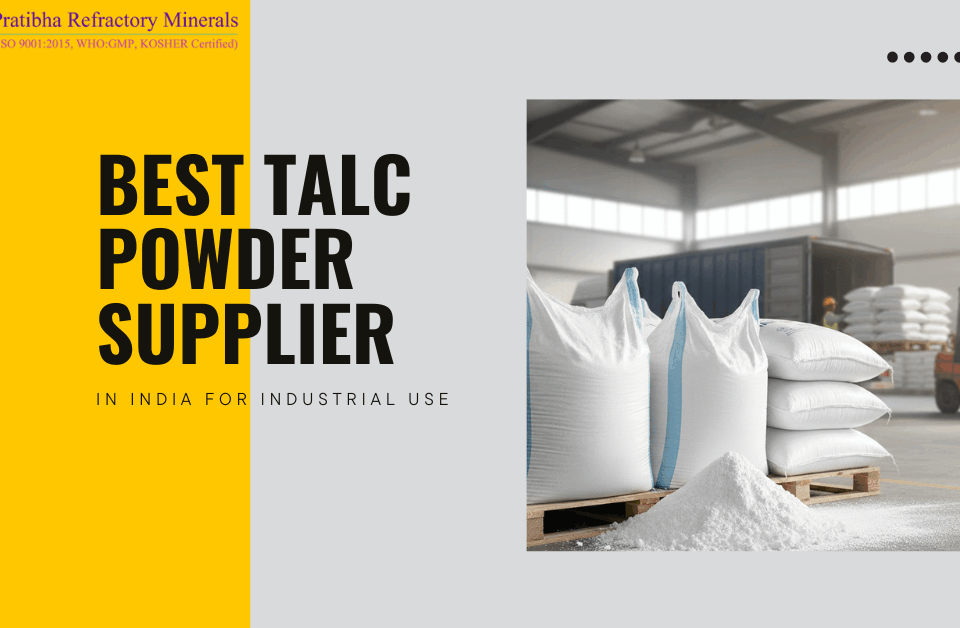- Call for Sales Enquiries

- +91-9413034047
- +91-294-2413244
- info@pratibharefractory.com
What Are the Different Applications of Dolomite Powder?

What Factors Influence the Pricing of Talc Powder Suppliers?
May 13, 2024
What Are the Multiple Advantages of Mica Powder?
June 10, 2024What Are the Different Applications of Dolomite Powder?

Pratibha Refractory Minerals is the leading Supplier of Dolomite, which provides high-quality Dolomite Powder for various industries. We have a dedication to quality and clients to offer a steady and dependable source for the construction, steel, agricultural, and glass markets. At Pratibha Refractory Minerals, you can trust for all your needs of dolomite that would be of superior quality and performance.
Understanding Dolomite Powder
Construction IndustryThe use of dolomite powder is paramount in the construction industry in the following major areas. In general, dolomite is incorporated into cement and concrete to enhance the strength of construction-related structures such as buildings and bridges. It has high compressive strength and excellent resistance to weathering that can assist in improving the performance of concrete. Also, dolomite is applied in the preparation of asphalt to be used in the construction of roads. The fine powder enhances the stability and strength of the asphalt pavements for long-lasting and highly resistant roadways.
Steel IndustryDolomite powder is used in the steel industry to produce high-quality steel since it plays a crucial role in the process. It is mainly used to aid in the removal of unwanted materials such as silica, phosphorus, and sulfur from molten iron through its use as a fluxing agent in blast furnaces. This process helps in the upgrading of the quality and purity of the steel. Dolomite acts as a fluxing agent in the production of steel and its purpose is to ensure that the chemical composition and the mechanical characteristics of the produced steel are as required.
AgricultureIn the field of agriculture, the use of dolomite powder is very significant for improving the quality of the soil as well as for providing nutrients to the plants. It is applied primarily to modify the pH of acidic soils thus making them more neutral for the growth of numerous crops. It not only aid in the correction of soil acidity but also supplies nutrients which are vital for the growth of plants. Such minerals help in the structure of the soil, water and root growth and overall healthy development of the plant. Also, it is used in the preparation of animal feed since it contains minerals like calcium and magnesium. The addition of dolomite in the animal feeds helps in providing the necessary minerals to the animal bodies thus enhancing their health and production.
Market Competition:
Having various suppliers available can bring competition in the market and an outcome of such competition may be a decrease in prices. Competitors, for example, may reduce prices via discounts, and/or launch new products, thereby attracting the attention of consumers. Hence, suppliers in the market might precociously alter their prices to maintain their attractiveness and profitability in the market. The worst starts when price competition may reach the highest level among those markets for talc powder containing no different factors between brands.
Geopolitical Factors:
Thousands of tons of talc are being mined in various parts of the planet while countries like China, the US, Brazil and India are the major sources of this mineral. Political uncertainty or trade disputes in these areas can impede supply chains in the market, which results in price fluctuation. i.e., some of the factors that could add to the cost of importing raw talc powder include the trade relations between the main producing nations and their importing counterparts, among others.
Currency Exchange Rates:
Talc powder trades globally, so its pricing in a local market is affected by the change in currency exchange rates. The strong currency in the country where the talc is produced may mean the exports would be more expensive for foreign buyers possibly resulting in the prices increasing in importing countries as well as the opposite occurring
Regulatory Environment:
Bylaws on extraction procedures, environmental safeguards, worker care, and product norms can affect the cost of making talcum powder. A flexible set of rules may require preventive measures like the purchase of new equipment, the introduction of safety measures or environmental repair, which will subsequently lead to an increase in production and pricing.
End-User Industries:
The demand for talcum powder fluctuates across industries broadly divided into cosmetics, pharmaceuticals, plastics, ceramics and paper. Disruption of consumer behaviour, technological achievements, and adjustments in regulatory provisions, all contribute to the turbulence of demand, and subsequently, to prices.


